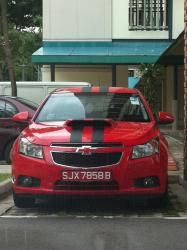Search the Community
Showing results for tags 'venture'.
-
- 11 replies
-
I'm too young to know this. any one can enlighten on this trade? it sounds very interesting. operates like a modern day bank. http://news.asiaone.com/news/singapore/singapore%E2%80%99s-first-%E2%80%98venture-capitalists%E2%80%99 Beside the Singapore River, near the Asian Civilisations Museum, sits a man made of bronze, in front of a low table. He has a large ledger open in front of him, a cloth draped over his shoulder, and his arm is raised as if in greeting. Who was this man? And how did he impact the development of Singapore? The sculpture, aptly named From Chettiar to Financier, was installed in 2002. It is artist Chern Lian Shan's representation of a man from a community that was known for its distinct role in Singapore's development as a trade centre: The Chettiars. Prior to 1900s, the Chettiars were nearly the only source of capital for entrepreneurs and as the earliest financiers, they have often been called the founders of modern banking. Trading background The Chettiars came from their homeland, which was in the southern region of Tamil Nadu (India), an area broadly known as Chettinad. Interestingly, the Chettiars did not begin as financiers. They began as traders, in the 18th century, trading salt and other commodities along the coastal region of Tamil Nadu, and by the 19th century, the Chettiars were already venturing out of their territory, and going overseas in search of new economic opportunities. They first migrated to Sri Lanka and Burma, where they continued trading, with financing being only a secondary business. The colonial authorities had no access to remote parts of these countries and were also unwilling to take the risk to lend to the people there, and so encouraged them. As their reputation as financiers began to grow in Burma, the Chettiars were drawn to new opportunities. Singapore, with its geographical proximity to China and Malaysia, was quickly becoming a natural hub for trade and finance. The Singapore River, especially, was an important thoroughfare, and so it followed that most trading activities occurred around that area. When the Chettiars arrived, they were one of the only communities who had ready capital to invest, and consequently, had no trouble setting up their businesses on the banks of the river, around Market and Chulia Streets. The Chettiars are often thought to have founded modern banking, because they introduced the concepts of debit, credit, expenditure, profit and loss. They were also perhaps the first in the region to introduce a unified document - the balance sheet - reflecting the financial status of a business. And they used this to evaluate the viability of each of the businesses they were financing. Additionally, they were meticulous in their record keeping. Dr Subramanian Thinnappan, a Tamil professor with the National University of Singapore, has researched the Chettiars and their migration since his own student days. He co-authored the book Nagarathars in Singapore with Mrs Soundara Nayaki Vairavan. He says: "The Chettiar accounting system was very different from the other (few) banks that existed. Firstly, it was in Tamil, and much of their calculation was done mentally. They were trained that way." Singapore Management University's Jayarani Tan and Tan Wee Liang have done extensive research on the early Chettiar community. Their research paper titled Informal Banking and Early International Entrepreneurs: The Case of the Chettiars was published in 2012. In their paper, they say that, although the Chettiars were not micro-financers in the way that we understand today, they were well known for their informal banking activities in the early part of the 19th century. The Chettiars financed everything from China's opium trade, to rubber, tin, real estate and retail. They also sometimes funded weddings, funerals and even education. Mr Subbiah Lakshmanan, an accountant and financial controller, has shared a lot of his family's photos and information about the early Chettiar community with the Asian Civilisations Museum. His grandfather Nachiappa Chettiar was one of the early financiers, and Mr Subbiah says that their business included many financial services, not just lending. "They provided working capital loans and investment capital as venture capitalists, syndicated loans for large undertakings, took deposits (with interest) and safekeeping of valuables, organised funds transfers to regional cities like Rangoon, Saigon, Medan, Kuala Lumpur, Chennai and Calcutta. They also issued demand drafts and discounting of demand drafts." The Chettiars were interested in lending only to entrepreneurs and only if there was a business interest attached. So rather than call them "moneylenders", Mr Subbiah stresses they were more financiers and venture capitalists. "They were 'private financiers', as they were described by the British," he adds. Many small traders, businessesmen or individuals who were unable to secure loans from the Chinese and European banks often turned up at the Chettiars' doors. Borrowing from the Chettiars was a simple, non-bureaucratic process. According to Dr Thinnappan: "It was easier for many businessmen to get the loans from the Chettiars, with IOU notes, and some collateral when the loans were high. The Chettiars also watched the borrowers closely, so they knew who was able to repay their loans, and who had businesses that were worth investing in." At times, if a substantially large loan amount was required, many Chettiar businessmen would pool their resources and lend the money, thereby sharing the risk of the investment. Interest rates varied, depending on the size of the loan and the party who was being lent the money. The rates of interest were fixed at a temple committee meeting each month and it could range anywhere from between 13 and fi Life in the kittingi The Chettiars operated their businesses out of kittingis, which were long narrow buildings, divided into several rooms of roughly 100 sq ft each. It was exclusively male and was used as both working and living quarters. Living and working together preserved their communal distinctiveness and also blurred the lines between work and community. Each kittingi functioned as a self-sufficient community, with an in-house cook, a regularly visiting barber and laundry man. Gambling and alcohol were not permitted and no women were allowed to stay in the kittingi. Mr Subbiah Lakshmanan, who grew up in such a kittingi, remembers his time there very fondly. "It was a simple life; our needs were simple. As young boys in the quarters, we were constantly engaged by what was going on around us. We had to take responsibility for ourselves and we were often sent off to do errands for the businessmen. "We felt very important doing those little tasks. And although our mothers were not there, we never felt lonely. There was always someone around and we knew which uncle to go to for sweets or ice cream!" A typical day at the kittingi began early, and the men worked until lunchtime. After the heat of the afternoon had passed, they met clients, and did the administrative work. Once the day's work was done, the Chettiar businessmen spent their evenings praying at the temple, playing cards and board games or light sports, like badminton. Occasionally, they treated themselves to a Tamil movie at the movie theatres in North Bridge Road, or spent the evening on the beach, near what is today the Esplanade. "The first 'Little India' in Singapore was not on Serangoon Road. It was around Market Street and Chulia Street, which is the area around Raffles Place today. There were Indian sari shops, spice grinders, and Indian eating places like Banana Leaf. And many business houses like Syed Mohammed Rice Traders, Jumabhoy's, Nomanbhoy's, Second Chance, Mohamed Mustafa, and P. Govindasamay Pillai all started there," says Mr Subbiah. The Chettiar businessmen didn't have the distraction of family, whom they had left in their homeland, so their leisure activities were simple. But, aside from the joys of communal living, life in the kittingi meant discipline. The younger male members of the family were interned into the business, drawing on the superior wisdom of the older members of the kittingi. Dr K. Vellayappan, a well-known paediatrician who consults at Mount Alvernia Hospital and at a clinic in Ang Mo Kio, also grew up in a kittingi. He says his experience of living there has stood him in good stead. "My father brought me to Singapore when I was just nine years old. Living in the kittingi, we learnt a lot. We started out as errand boys, running around getting things, buying stamps or getting papers stamped. We worked hard, and it really moulded our character," he recalls. For any young boy who joined kittingi life, there was also a clear career path laid out. He would typically begin as an office boy and progress to becoming a clerk. By his mid-20s, if he were seen to have an aptitude for the business, would rise to the level of a kootali or agent and then progress to becoming a pangaali or partner, after which he himself became the owner, the mudalaali. Through this method, the Chettiars also learnt how to preserve their own best practices. And, interestingly, there was no nepotism. Every boy was treated fairly and with discipline, regardless of whether they were family or not. - See more at: http://news.asiaone.com/news/singapore/singapore%E2%80%99s-first-%E2%80%98venture-capitalists%E2%80%99#sthash.Fq4Q9QLs.dpuf
-
Cargill Inc., the agriculture and trading giant, said Thursday that it would close a division that trades coal, as well as European power and gas, after a strategic review of the businesses. Cargill, one of the world's largest privately owned companies, said in a statement that it is exiting the businesses because of "significant changes in the coal and European power and gas markets." It didn't identify those changes. Separately, Cargill and Copersucar SA, a Brazilian sugar and ethanol trader, agreed to combine their global sugar-trading activities, creating a new joint venture that will source and trade sugar. The Geneva-based energy-trading operation Cargill is closing is part of its energy, transportation and metals division. Cargill estimates it buys nearly $5 billion of energy a year. Reduced coal consumption in some countries, such as the U.S., has lifted global supplies of coal in recent years and depressed prices, intensifying competition for markets that still need the fuel. Coking coal, used for making steel, is trading at its lowest level in eight years, while prices of thermal coal, used in power generation, are the weakest since 2009. Cargill said it would continue to trade in petroleum, petrochemicals, iron ore and steel, ocean freight and North American gas and power markets. Last month, SparkSpread.com, an energy-market publication, reported that Cargill suffered losses of at least $100 million trading in energy markets early this year, mostly in mid-Atlantic power markets. The publication didn't cite a source for its information. Pete Stoddart, a spokesman for Cargill, said Thursday that the company doesn't disclose the results of individual business units, but said the $100 million-loss figure was inaccurate. He said the decision to exit the coal and European power businesses was unrelated to the U.S. power operation. The Cargill-Copersucar sugar venture will be 50%-owned by each company. Other financial terms weren't disclosed. The venture will benefit from a large supply of sugar from Copersucar's partner mills in Brazil, the world's largest sugar producer and exporter, and from both companies' logistics-management experience, the companies said. The venture's trading activities will be based in Geneva, with offices in locations including Hong Kong, São Paulo, Brazil; Miami, Moscow and Dubai. Ivo Sarjanovic, who leads Cargill's sugar business, will be chief executive once the new company is formed, which is expected in the second half of 2014. Copersucar Chairman Luis Roberto Pogetti will become the first chairman of the venture, a post that will rotate. Both companies' ethanol businesses and fixed assets, such as terminals and mills, are excluded from the transaction. Each company will continue to own its own logistics and infrastructure facilities, but these will serve the joint venture, according to a spokesman for Copersucar. The deal will help Copersucar shore up its logistics reach after a massive fire in October damaged six of its Brazilian sugar warehouses, used to store and ship sugar at the port of Santos. Shipments of sugar from the port dropped by about 40% after the fire. Copersucar is repairing its Santos terminal and by February 2015 expects to have the capacity to receive and ship 10 million tons of sugar a year, an average of about 800,000 to a month, up from a current 250,000 a month. The deal comes as other commodity companies have struggled in the sugar business. Bunge Ltd. last month said it hired Morgan Stanley to advise on a strategic review of its money-losing sugar milling operation, which has been hurt by low world sugar prices and caps on the price of ethanol produced from sugar cane in Brazil. Archer Daniels Midland Co., in financial results reported in February, recorded a $50 million impairment of its investment in a Brazilian sugar mill, based on a new assessment of future cash flows from the business. Cargill, founded in 1865, has diverse operations including processing meat, selling steel and making pharmaceutical ingredients, in addition to trading grain, energy and other commodities and transporting goods across a sprawling global logistics network.
-

Lamborghini to venture outside of the sports supercar market
FaezClutchless posted a blog entry in MyAutoBlog
[extract] Lamborghini is famous for its Countach, Diablo and Gallardo. The name Lamborghini itself is synonymous with fast sports cars. They have been making sports cars ever since the company was founded by Ferruccio Lamborghini in 1963 and the only time they made a vehicle that-
- new model
- other news
-
(and 9 more)
Tagged with:
-
Hi Bro, Saw this Chevrolet Cruze bonnet come with a massive intake scoop ????? wannabe STI !!!! I think Chevrolet joint venture with Subaru.............came out with new model.
-
Hello all. I've been seriously considering venturing into using a RO to achieve better results than by hand. 1) Which is a good RO? Is the Porter Cable 7424 good? Where to get it locally? 2) What kind of pads do I need? Edge/Lake Country? 3) Where can I learn how to use a RO properly? 4) Is the Menzerna system of polishes recommended? The only thing that's preventing me from going ahead is the fact that using a RO wrongly can burn the paint. Would appreciate any advice from those who have experience in RO. Like Gen2?
-
A good friend of mine send this to me. Boy, I was surprise when I saw the cross bred. Presenting, the latest model from Subaru and Kia Joint venture. [inline IMAGE_134.01.JPG] No just 1, but added 3 emblem to double confirm the 'model'........... I wonder whether does this model comes with Turbo. [inline IMAGE_135.01.JPG]










